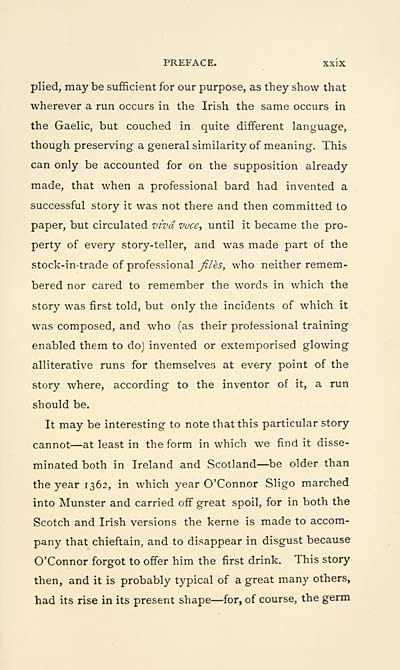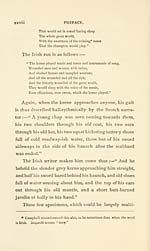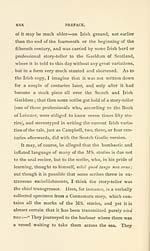Blair Collection > Beside the fire
(33)
Download files
Complete book:
Individual page:
Thumbnail gallery: Grid view | List view

PREFACE. xxix
plied, may be sufficient for our purpose, as they show that
wherever a run occurs in the Irish the same occurs in
the Gaelic, but couched in quite different language,
though preserving a general similarity of meaning. This
can only be accounted for on the supposition already
made, that when a professional bard had invented a
successful story it was not there and then committed to
paper, but circulated znvd voce^ until it became the pro-
perty of every story-teller, and was made part of the
stock-in-trade of professional fJes, who neither remem-
bered nor cared to remember the words in which the
story was first told, but only the incidents of which it
was composed, and who (as their professional training
enabled them to do) invented or extemporised glowing
alliterative runs for themselves at every point of the
story where, according to the inventor of it, a run
should be.
It may be interesting to note that this particular story
cannot — at least in the form in which we find it disse-
minated both in Ireland and Scotland — ^be older than
the year 1362, in which year O'Connor Sligo marched
into Munster and carried off great spoil, for in both the
Scotch and Irish versions the kerne is made to accom-
pany that chieftain, and to disappear in disgust because
O'Connor forgot to offer him the first drink. This story
then, and it is probably typical of a great many others,
had its rise in its present shape — for, of course, the germ
plied, may be sufficient for our purpose, as they show that
wherever a run occurs in the Irish the same occurs in
the Gaelic, but couched in quite different language,
though preserving a general similarity of meaning. This
can only be accounted for on the supposition already
made, that when a professional bard had invented a
successful story it was not there and then committed to
paper, but circulated znvd voce^ until it became the pro-
perty of every story-teller, and was made part of the
stock-in-trade of professional fJes, who neither remem-
bered nor cared to remember the words in which the
story was first told, but only the incidents of which it
was composed, and who (as their professional training
enabled them to do) invented or extemporised glowing
alliterative runs for themselves at every point of the
story where, according to the inventor of it, a run
should be.
It may be interesting to note that this particular story
cannot — at least in the form in which we find it disse-
minated both in Ireland and Scotland — ^be older than
the year 1362, in which year O'Connor Sligo marched
into Munster and carried off great spoil, for in both the
Scotch and Irish versions the kerne is made to accom-
pany that chieftain, and to disappear in disgust because
O'Connor forgot to offer him the first drink. This story
then, and it is probably typical of a great many others,
had its rise in its present shape — for, of course, the germ
Set display mode to: Large image | Transcription
Images and transcriptions on this page, including medium image downloads, may be used under the Creative Commons Attribution 4.0 International Licence unless otherwise stated. ![]()
| Early Gaelic Book Collections > Blair Collection > Beside the fire > (33) |
|---|
| Permanent URL | https://digital.nls.uk/76244058 |
|---|
| Description | A collection of Irish Gaelic folk stories. |
|---|---|
| Shelfmark | Blair.222 |
| Additional NLS resources: | |
| Attribution and copyright: |
|
| Description | A selection of books from a collection of more than 500 titles, mostly on religious and literary topics. Also includes some material dealing with other Celtic languages and societies. Collection created towards the end of the 19th century by Lady Evelyn Stewart Murray. |
|---|
| Description | Selected items from five 'Special and Named Printed Collections'. Includes books in Gaelic and other Celtic languages, works about the Gaels, their languages, literature, culture and history. |
|---|

